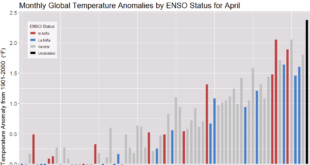The NSIDC has a Greenland Surface Melt Extent Interactive Chart. For the graph here we selected 2012, 2016, and 2019 (blue). There was an early peak this year on June 12, 2019. How is this data collected (from Greenland Ice Sheet Today – About the Data):
Near-real-time images are derived from gridded brightness temperatures (TBs) from the Defense Meteorological Satellite Program (DMSP) Special Sensor Microwave Imager/Sounder (SSMIS) passive microwave radiometer. The TBs are calculated for each 25 kilometer grid cell. An algorithm is applied to produce an estimate of melt or no melt present for each grid cell. The data, images, and graphs are produced daily.
The colored areas on the daily image map records those grid cells that indicate surface melt from the algorithm, as a binary determination (melt / no melt). The melt extent graph indicates what percent of the ice sheet area is mapped as having surface melt, again from the binary determination per grid cell, using the summed area of the melt grid cells divided by the total ice sheet area.
Learn more at the NSIDC Greenland Ice Sheet Today page. The data that is used to create the graph here doesn’t appear to be easily accessible. If you are interested and email may do the trick.
A recent Guardian article, Photograph lays bare reality of melting Greenland sea ice by Alison Rourke and Fiona Harvey (6/17/19) has an excellent photo of sled dogs appearing to walk on water. The article provides some context related to Greenland and ice.

